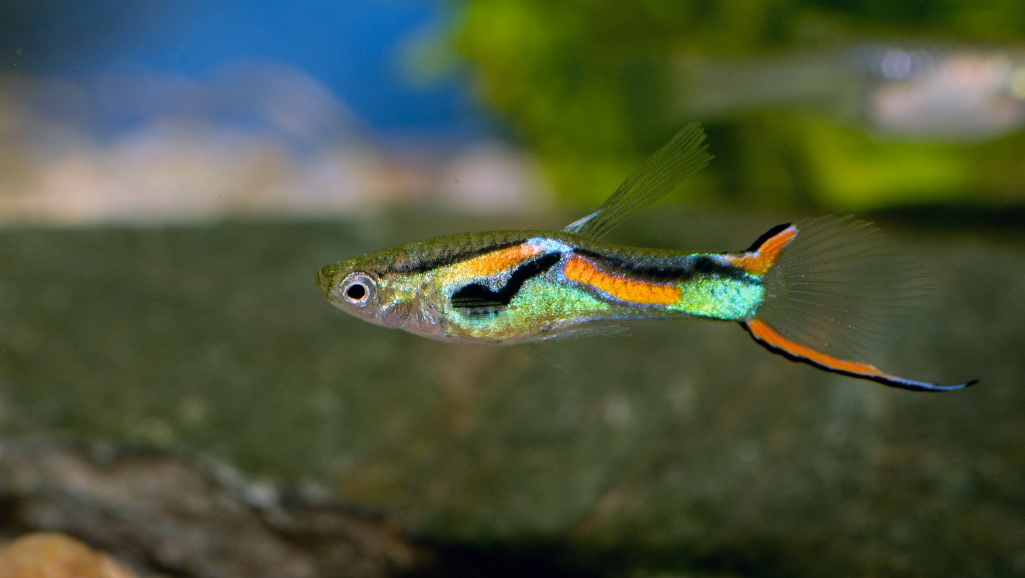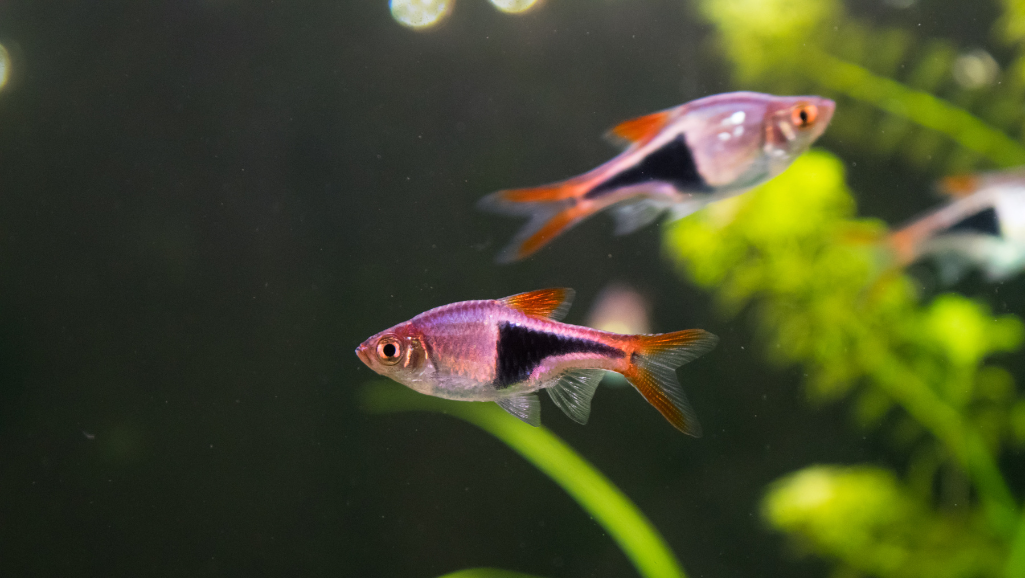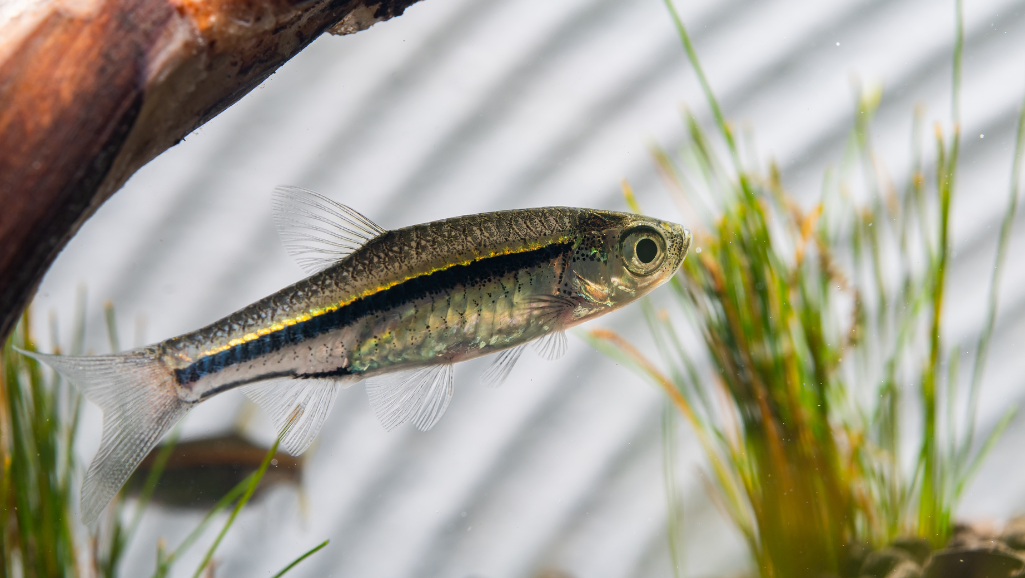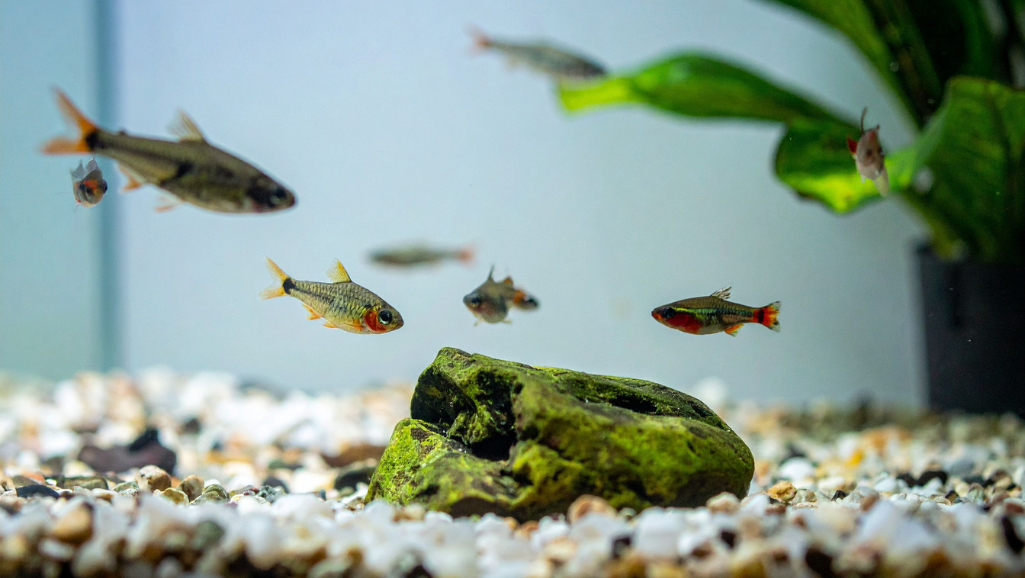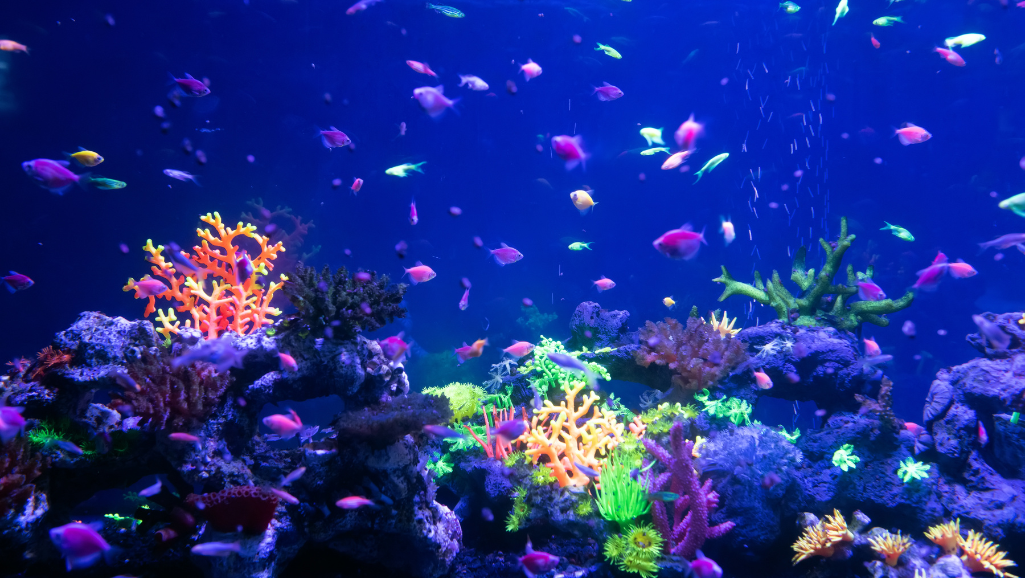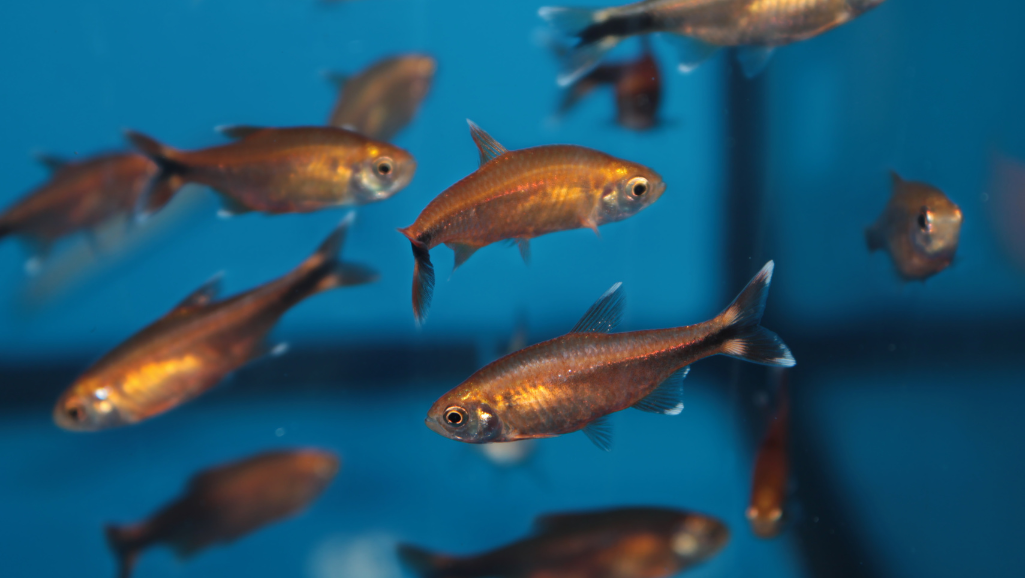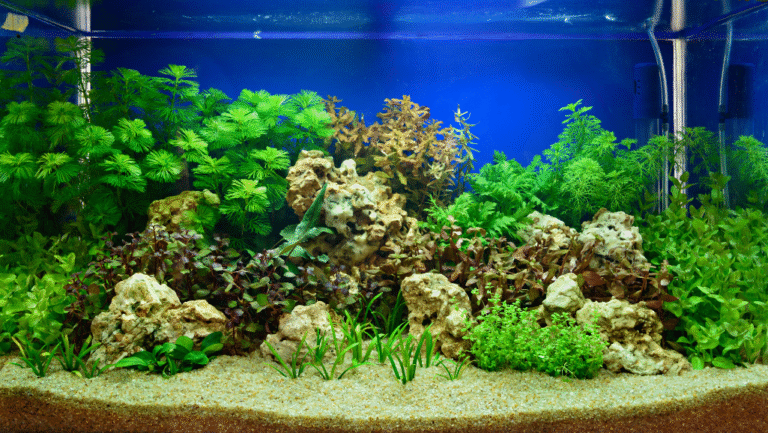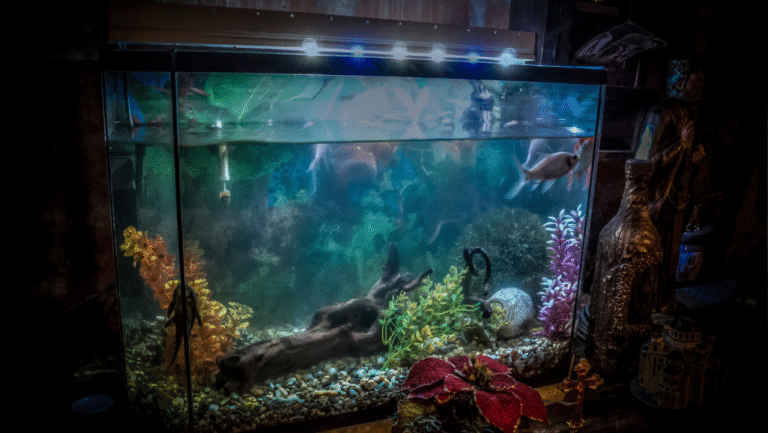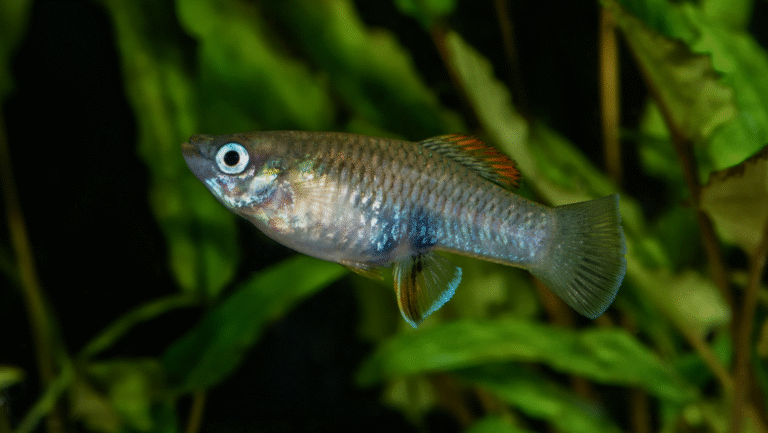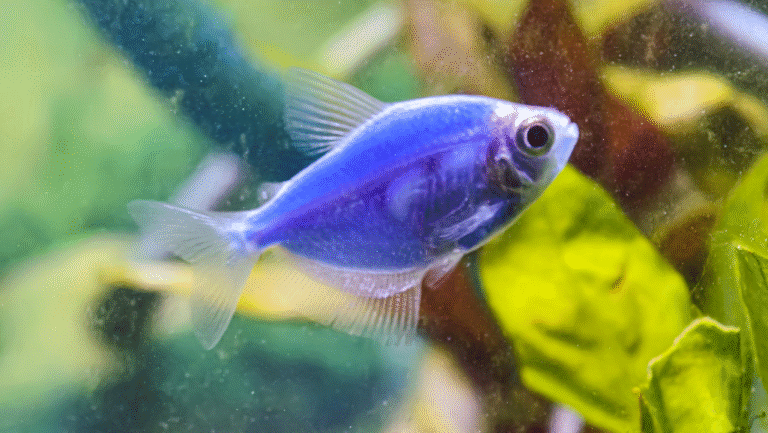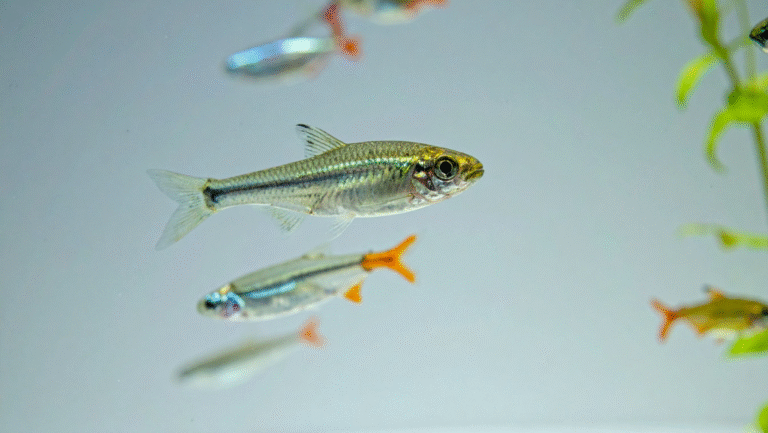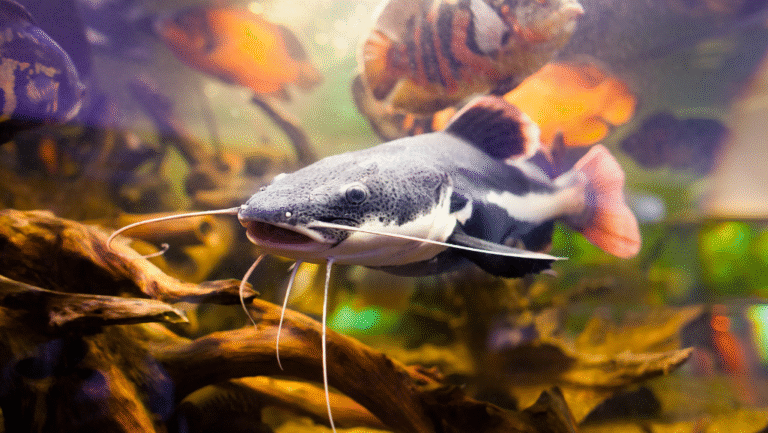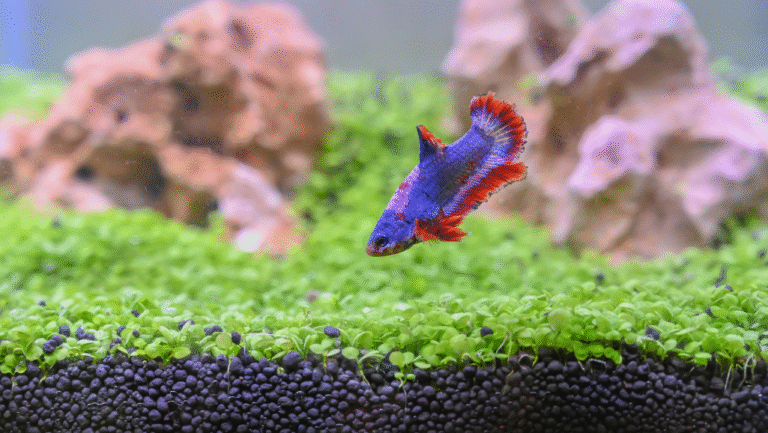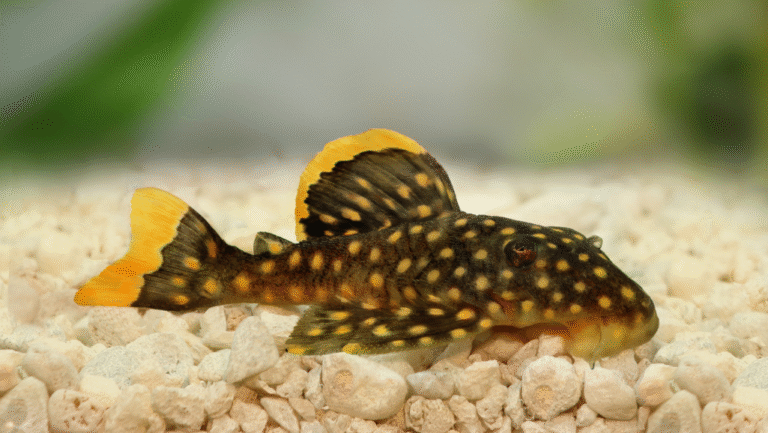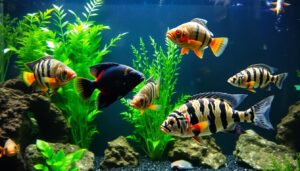Create a calm, colorful aquarium that fits your life and your tank size. This guide helps you pick the best freshwater aquarium fish—peaceful, easy-care choices that add motion and long‑term enjoyment to any home.
Choosing the right fish is the most important choice for a healthy community: matching species to available space, water conditions, and feeding habits reduces stress, limits quarrels, and shortens maintenance time.
We prioritize schooling shimmer at the top, lively midwater swimmers, and helpful bottom dwellers that keep the substrate tidy. Most recommended aquarium fish accept flakes or micro‑pellets and adapt well to typical home filters and heaters.
Each profile below includes practical steps—recommended stocking, simple aquascape tips, and straightforward care routines. Use the one‑inch‑per‑gallon guideline only as a baseline (it doesn’t replace considerations like adult size, body mass, or filtration). Thoughtful planning prevents overcrowding and builds a balanced tank that beginners and busy pet keepers can maintain.
Key Takeaways
- Select species that match your tank size and water conditions so neighbors get along and stress stays low.
- Balance top, mid, and bottom fish for natural movement and a tidy display.
- Prefer tolerant eaters (flakes, micro‑pellets, occasional frozen treats) to simplify feeding.
- Treat “one inch per gallon” as a rough start—always check adult size and bioload for each species.
- Stock gradually, plan aquascape lanes, and add hiding spots to create a relaxing, colorful world in glass.
Starter kit for busy beginners: a 20‑gallon tank with a group of 6 neon tetras (midwater), 4–6 corydoras (bottom), and 4 platies (mid/top) makes a lively, low‑stress community that’s easy to care for. Pick captive‑bred specimens where possible to ensure hardiness and to protect wild stocks.
Ready to begin? Choose your tank size, set stable water parameters, and start with the three species above—then add more tank mates slowly as your confidence grows. These simple steps help your aquarium fish come together into a calm, living display.
Why Choosing the Right Freshwater Fish Makes Your Aquarium Shine
Picking compatible species determines how calm and colorful your aquarium looks and behaves every day. Smart choices lower fighting and stress, so the entire community appears relaxed, displays natural movement, and holds color better.
Temperament and activity level shape what you see: peaceful fish that get along swim in smooth schools and create graceful motion that highlights color without chaos. That coordinated movement makes daily viewing soothing and predictable.
Size, diet, and bioload matter for water clarity and maintenance time. Stocking to adult size and expected waste output—rather than relying solely on the one‑inch‑per‑gallon rule—keeps water clear and filter loads manageable. Consider adult length, body mass, and filtration capacity when you plan.
- Match temperaments and adult size to avoid conflict and protect shy species.
- Use schooling species such as neon tetras or zebrafish to add midwater shimmer and coordinated movement.
- Provide plants and hiding places so timid fish relax and show their true color.
For practical tank‑size guidance and exact stocking examples, see the Tank Size and Top Picks sections below—these show compatible mixes (for example, a modest 20‑gallon community with 6–8 neon tetras, 4 corydoras, and a couple of platies) that balance movement, bioload, and space.
“A well-planned stocking plan means fewer conflicts and a tank that looks curated every hour.”
How We Picked the Best: Peaceful Temperaments, Easy Care, and Community Fit
We focused on hardy, social fish that add movement and color without extra fuss. Recommendations come from practical, repeatable checks designed for common home aquariums so readers get reliable results.
Beginner-friendly species and low-maintenance care
Priority went to species that readily accept flakes and pellets, show consistent health in moderate tanks, and tolerate typical household water parameters—making them ideal for busy keepers who want easy care and quick success.
Compatibility and getting along in community tanks
We screened each candidate by adult size, temperament, and activity level. The kinds that swim together calmly—schools and peaceful midwater species—tend to avoid chasing and display natural schooling behavior. Matching pace and size reduces conflict and keeps the community tank calm.
Color, patterns, and schools that inspire
Visual appeal mattered: we favored stripes, gradients, and compact forms that stand out in groups without triggering aggression. Schools amplify pattern and color, turning many different small fish into a single striking element.
- Selection criteria: peaceful, social, easy diet (flakes/pellets).
- Beginner focus: captive‑bred, hardy species documented for low‑maintenance care.
- Compatibility checks: tests for feeding acceptance, stress indicators, and pairing by size/activity.
“A well-chosen community boosts color and calm more than any single centerpiece.”
Tank Size and Space: From Nano Tanks to 50+ Gallons
Tank dimensions and layout determine how lively, calm, and stable your aquatic community will be. Choose the right size first—then pick fish that match the available space and filter capacity.
One‑inch‑per‑gallon can be a helpful starting rule (roughly one inch of adult length per net gallon), but use it only as a baseline. It ignores body mass, heavy bioload, filtration strength, and territorial behavior. A better approach is to consider adult size, expected waste output, and your filtration when planning stocking levels to avoid cloudy water and stressed fish.
Practical limits and species planning
Match species to realistic space needs. For example, many neon tetras and dwarf gouramis do well in 10‑gallon or larger setups (with proper groups), bristlenose plecos are comfortably kept from about 30 gallons upward, and active loaches or larger “shark”‑type species (e.g., bala sharks) usually need 50 gallons or more. Always check adult length and temperament before you buy.
Aquascape, lanes, and substrate
Design swim lanes and vertical zones to suit your chosen species: horizontal lanes for danios and rainbowfish, tall open water for angelfish, and soft sand for bottom sifters to protect barbels.
- Create planted margins and open midwater zones so schools have room to swim without bumping territories.
- Add rock or driftwood to give bottom dwellers hiding spots and grazing surfaces.
- Break lines of sight with plants or décor so shy fish find cover and stress drops.
“More room equals more stable parameters and a calmer tank.”
Quick guide: If you have a 10‑gallon tank, aim for small schooling and nano species; 20–30 gallons lets you add midwater groups and small bottom crews; 50+ gallons supports larger schools and heavier bioloads. Plan space and filtration upfront to create a best aquarium setup with fewer surprises later.
The Best Fresh Water Fish for Beginners and Busy People
For busy beginners, a handful of hardy livebearers deliver color and low-maintenance charm in modest tanks.
Guppy: colorful, peaceful, and prolific
Guppies are the classic starter fish: small, hardy, and accepting of flakes and micro‑pellets. They adapt well to typical household water and basic filtration, making them ideal freshwater aquarium fish for new keepers.
Guppies get along with many different peaceful species such as small tetras and corydoras, which helps create a calm community. They breed readily—if you don’t want fry, keep males only or plan for rehoming; if you do want fry, provide dense plants or a breeder box to protect young.
Practical stocking tip: in a 10–20 gallon tank, start with 6–8 guppies and monitor water parameters as the population stabilizes. Regular, small water changes and consistent feeding keep guppies healthy with minimal fuss.
Platy and Molly: hardy, active tankmates that thrive on staples
Platies and mollies are forgiving livebearers that eat standard flakes and pellets and do fine on once‑daily feeding plus occasional frozen treats. They add motion and color without complex care demands.
The Red Wagtail Platy is an eye‑catching choice that suits a well‑planted 10‑gallon or larger tank; for stable behavior, aim for small groups rather than singletons. These species make excellent tank mates for tetras and corydoras when water parameters are compatible.
- Small size, big impact: a few livebearers bring lively movement to modest tanks.
- Manageable groups: start with a small, mixed group (example: 6–8 guppies or 4 platies in a 10–20 gal) and manage fry by plant cover or rehoming if needed.
- Simple routine (starter checklist): heater, sponge or gentle filter, test kit, 6–8 guppies or 4 platies, and several hardy plants.
“Begin with forgiving species to build confidence before expanding your stocking plan.”
Busy‑keeper action: choose captive‑bred fish when possible (they’re hardier), maintain a weekly quick check (temperature, ammonia, nitrite), and feed quality flakes/pellets. That combination gives you a bright, easy‑care community that shows color and movement without heavy time commitment.
Peaceful Schooling Beauties That Elevate Any Community
When small groups move in coordinated schools, an aquarium gains depth, steady movement, and effortless charm. Schools create a unified ribbon of color and motion that reads as a single dynamic element across the tank.
Neon Tetra and Bloodfin Tetra: shimmer, stripes, and schools
Neon tetras deliver that classic blue-and-red flash when kept in groups. For visible, confident schooling behavior, plan for at least 6–8 neon tetras in a 10–20 gallon tank with planted midwater lanes—this gives the school room to form and reduces stress.
Bloodfin tetras complement neon groups with contrasting tones and lively movement; they generally get along with other peaceful midwater schooling fish when kept in proper schools.
Zebrafish (Danio rerio) and GloFish Danio: hardy, fast, and vibrant
Zebrafish show bold horizontal stripes and energetic schooling motion. They are tolerant of a range of water conditions and accept flakes and micro‑pellets. GloFish Danio offers the same hardy behavior with fluorescent hues under blue LEDs. Keep danios in schools of six or more and provide open lanes for their active movement.
Boeseman’s Rainbowfish: bold colors in groups
For larger tanks (30 gallons+), Boeseman’s Rainbowfish produce broad two‑tone gradients that shift beautifully in groups. Aim for groups of six or more so they display natural schooling and color to full effect; match them with similar‑sized midwater tank mates to protect balance and reduce chasing.
“Lighting and a dark background make stripes and shimmer pop while keeping stress low.”
- Keep schools of six+ (often 6–10) to encourage tight formations and confident schooling behavior.
- Match similar‑sized species so schools and tank mates get along and the community stays balanced.
- Use subdued lighting and a dark backdrop to make colors read stronger while reducing glare and stress.
For stocking examples and compatible midwater pairings in community tanks, see the Community Tank and Top Picks sections—schools of tetras, small danios, and compatible bottom crews create lively, low-conflict freshwater communities.
Essential Bottom Dwellers: Catfish and Loaches That Keep Things Tidy
Reliable bottom dwellers tidy leftovers, graze algae, and add quiet life beneath the plants—making them essential for a balanced aquarium community.
Corydoras are small, social catfish that sift substrate in friendly groups. Keep six or more so they display natural foraging and feel secure; soft sand protects their barbels and encourages normal behavior.
Corydoras catfish: friendly families and substrate sifters
Corydoras (for example, Corydoras aeneus and similar species) are hardy, peaceful, and great at finding bits of food in planted tanks. They make ideal bottom tank mates for many different midwater schooling fish.
Bristlenose Plecostomus: algae helper with personality
Bristlenose plecos (Ancistrus sp.) are popular algae eaters that suit 30‑gallon and larger tanks; they accept sinking wafers and occasional vegetables. Note: “pleco” is a catch‑all—larger Hypostomus species need much more space than an Ancistrus bristlenose.
Kuhli Loach and Hillstream Loach: eel-like charm and flow lovers
Kuhli loaches have slender, eel‑like bodies and prefer fine sand, plentiful caves, and groups of five or more. Hillstream loaches need strong flow, high oxygen, and smooth rocks to graze; they thrive in well‑oxygenated, current‑rich zones.
Royal Whiptail Catfish: unique form and peaceful nature
The royal whiptail (Rineloricaria and relatives) adds an elegant, peaceful bottom presence in larger, stable tanks. It will accept algae wafers and sinking pellets and usually coexists calmly with gentle tank mates.
Feeding tip: schedule sinking wafers or algae tablets nightly for herbivores and place a small portion of flakes or pellets near caves after lights dim so bottom feeders can access food. For mixed communities, target‑feed the middle column then drop a wafer to the substrate so bottom species don’t starve.
- Do: use fine sand or very fine gravel to protect barbels and allow natural sifting.
- Don’t: use sharp substrate or overcrowd the bottom—many species need space to forage.
- Groups: most social bottom species do best in groups (corydoras 6+, kuhli loaches 5+).
- Flow & oxygen: hillstream types require current and strong aeration.
Standout Centerpieces: Eye-Catching Aquarium Fish for Impact
A single showpiece can lift an entire tank, drawing the eye and setting the room’s mood. Choose one centerpiece per visual zone so the layout stays calm, balanced, and friendly to other tank mates.
Koi Angelfish: graceful stature for medium tanks
Koi Angelfish shine in 30‑gallon (or larger) tanks with good vertical clearance. Their tall bodies and flowing fins create a gallery‑like presence, but note they can be semi‑aggressive—pair them with calm, similar‑sized companions (e.g., larger tetras or peaceful gouramis) and provide tall plants and open front space for comfortable viewing.
Powder Blue Dwarf Gourami & Honey Gourami: gentle labyrinth species
Powder Blue Dwarf Gouramis thrive in planted displays with floating cover and low flow; a 10–20 gallon area suits a single dwarf gourami or a small peaceful pairing. Honey Gouramis are more sensitive—keep water stable and offer quiet zones; both appreciate floating plants for bubble‑nesting and resting near the surface.
Crowntail Betta: a dramatic solo star
Crowntail Bettas make bold nano centerpieces. Because male bettas can be aggressive toward similar fish, a solo male is the safest choice in smaller tanks, or carefully pair him with peaceful, non‑fin‑nipping schooling tank mates (tiny rasboras or some small tetras) in adequately planted tanks with ample hiding spots.
- Aquascape tips: open front viewing for tall fish, floating cover for labyrinth species, and plenty of hiding spots to reduce territorial displays.
- Stocking rule: one centerpiece per zone—avoid multiple dominant fish in the same visual area.
- Bring out color: stable water, a varied quality diet, and gentle flow highlight fins and body color without stressing the fish.
“Choose a centerpiece that enhances the community, never dominates it.”
Cichlids with Charm: Peaceful Picks for Community and Semi-Community Tanks
Certain cichlid species bring striking color and personality while still fitting into a peaceful community when you choose the right tank mates and décor.
Keyhole cichlids are understated, semi‑peaceful fish from South America that do well in semi‑community tanks. They prefer rock caves and moderate cover; pair them with peaceful midwater schools and small bottom dwellers to reduce territorial stress.
Kribensis (Pelvicachromis spp.) offer bright flashes of color and adaptable temperaments if tanks are not overcrowded. They accept micro‑pellets and frozen foods and integrate well into planted setups when provided with hiding spots and modest territories.
Bolivian rams form strong pair bonds and display parental care. Keep them in a stable 30‑gallon tank or larger with soft, slightly acidic water for best behavior; expect increased territoriality during breeding and provide extra cover or temporary dividers if needed.
Agassiz’s dwarf cichlid (Amazonian dwarf species) is jewel‑toned and shy—heavy planting, stable parameters, and plenty of cover let it stake small, gentle territories without bullying neighbors.
- Compatible companions: peaceful midwater schools (small tetras, rasboras) and modest bottom crews (corydoras).
- Diet: varied micro‑pellets, frozen foods, and occasional live treats to boost color and condition.
- Scape tip: provide caves, plant thickets, and clear sightline breaks to diffuse tension and let shy species retreat.
When to choose a cichlid: pick milder species if you want color with community compatibility; ensure tank size, water chemistry, and cover match the species’ needs. Typical parameters: stable temperature ~75–80°F, pH and hardness vary by species—check specific profiles before purchase.
Watch closely during breeding phases and be prepared to add cover or temporary dividers to maintain harmony in semi‑community environments.
Transparent and Unusual: Cool Freshwater Fish That Spark Wonder
Transparent and translucent species add a crystalline calm to an aquarium—subtle motion and fine detail that reward patient observation rather than loud color. These kinds of fish suit hobbyists who want delicate movement and curiosity‑inspiring visuals.
Glass Catfish and Indian Glassfish
Glass catfish (Kryptopterus spp.) are mesmerizing in schools: keep five or more so they feel secure and exhibit synchronized swimming. They are best in tanks with stable water and at least moderate volume (many keepers recommend ~30 gallons for reliable schooling behavior).
The Indian glassfish (Parambassis spp.) prefers open lanes and well‑oxygenated water. Provide gentle current, steady aeration, and calm midwater neighbors so these fish cruise confidently and show their unique translucence.
Peacock Gudgeon
The peacock gudgeon is a compact, colorful micro‑predator that works well in 15‑gallon or larger tanks. It’s a peaceful omnivore that accepts fine flakes and micro‑pellets and pairs well with non‑aggressive tank mates that won’t outcompete it for food.
- Keep these species in small groups or compatible pairs to reduce stress and encourage steady swimming.
- Use a dark background, subdued light, and gentle flow to increase contrast and make translucent bodies more visible.
- Feed fine flakes, micro‑pellets, and occasional frozen treats placed midwater or near cover so shy eaters get nutrition.
“Translucent species reward patient observation—small details unfold over time.”
Small Wonders: Nano-Friendly Aquarium Fish with Big Personalities
Nano tanks can host lively personalities in tiny packages that reward close observation. When you pick small freshwater aquarium fish that school and remain confident in limited space, a 10–20 gallon tank can become a vivid, low‑maintenance display.
Boraras brigittae: tiny rasboras for planted tanks
Boraras brigittae are micro rasboras that light up planted tanks with delicate hues. For tight, synchronized schooling motion aim for a group of 8–10 in a well‑planted 10‑gallon setup; they show best when given dense foreground plants and fine substrate.
Scape tip: dense planting, fine sand or very fine gravel, and small caves create scale‑appropriate vistas where their subtle colors pop.
Celestial Pearl Danio: polka-dot beauty in groups
Celestial Pearl Danios bring polka‑dot patterns and orange fins that glow against greenery. They prefer open lanes within lush planting and do best in steady groups—plan for at least 6–8 to encourage schooling and confident movement.
- Use gentle filtration (sponge or low‑flow canister outlets) and monitor parameters frequently—small volumes change quickly.
- Feed powdered flakes, micro‑pellets, and baby brine shrimp so tiny mouths get balanced nutrition.
- Maintain cohesive groups to encourage natural schooling and reduce stress.
“One well-chosen feature and careful scaping make a nano tank feel expansive.”
Practical nano checklist: a 10‑gallon tank, gentle filter, small heater, 8–10 Boraras or 6–8 Celestial Pearl Danios, several carpet plants, and a testing kit. Be patient—small species reveal personality through subtle interactions and foraging, and weekly parameter checks help keep your miniature community stable and beautiful.
Color That Pops: Reds, Blues, and Stripes That Light Up Your World
Vivid hues and crisp stripes turn a planted tank into a living canvas. Use bold midwater tones and contrasting foreground accents to build depth while keeping the scene calm and cohesive.
Neon tetra blues and rainbowfish gradients
Neon tetras deliver an iconic iridescent blue band with a flash of red at the tail—especially striking in groups. Pairing them with Boeseman’s Rainbowfish produces two‑tone gradients that shift as the school moves, creating a dynamic ribbon of color across the midwater.
Tip: place these species in planted midwater lanes against a dark background; subdued lighting (neutral to slightly cool LED, ~6000–7000K) helps blues and gradients read richer without stressing the fish.
Red wagtail platy and striped zebrafish for contrast
Use the Red Wagtail Platy to add warm red accents in the foreground or midwater, and put striped zebrafish (danios) in upper lanes to introduce bold horizontal motion that contrasts with vertical plant forms.
- Balance warm and cool tones—mix reds or oranges with blues and greens so colors amplify rather than clash.
- Choose a dark substrate and lush green plants to deepen perceived hues and reduce glare; a matte background intensifies stripes and contrast.
- Use staged lighting with gentle ramp‑ups in the morning to coax shy fish out and let colors bloom under stable conditions.
- Combine mixed textures—fine‑leaved stems, broader sword leaves, and driftwood—to frame vivid species without visual competition.
“A thoughtful palette makes your best aquarium feel like a small, vibrant world.”
Community Success: Which Fish Get Along Well Together
Successful community tanks depend on sensible mixes and thoughtful spacing to keep tensions low.
Pair schooling tetras in the midwater with a group of corydoras on the bottom and add a few platies for steady mid/top activity. A dwarf gourami or two can provide calm presence without crowding lanes. These combinations help tank mates get along and keep feeding times peaceful.
Size and temperament matter: match similar adult size so timid species are not bullied. Avoid long‑finned tank mates with known fin nippers, and never house two male bettas together.
When including semi‑aggressive centerpiece species like angelfish, select quick midwater companions of similar size and give extra space. During breeding, cichlids and livebearers often become protective—add cover and monitor closely, adjusting stocking if required.
- Proven mix: tetras (schools), corydoras (bottom harmony), platies (mid/top motion), dwarf gouramis (calm midwater).
- Quarantine: keep new arrivals isolated for 7–14 days to protect the existing community and avoid introducing parasites or diseases.
- Space & filtration: give plenty of room, line‑of‑sight breaks, and adequate filtration to manage bioload and territory issues.
“Observe, feed evenly, maintain water quality, and adjust stocking if persistent issues arise.”
Quick checklist: observe behavior daily, spread feeding to avoid hogs (target feed shy species), test water weekly, and reduce stocking if conflicts persist. These simple steps help your community fish get along and keep the aquarium calm.
Diet, Food, and Feeding Time: Flakes, Pellets, and Live Treats
A clear feeding plan keeps colors bright and stress low in a community tank. Start with a simple baseline most species accept, then tailor additions for bottom dwellers and color‑boosting treats.
Staples that work:
Staples that work
Offer quality flakes and micro‑pellets as the daily core of the diet. These staples satisfy the majority of community fish and simplify routine feeding, helping maintain steady water chemistry in a busy tank.
Include algae wafers or sinking herbivore pellets so bottom feeders and grazing tank mates get access to their preferred food without competing at the surface.
Meaty additions
Rotate frozen or safely sourced live treats—bloodworms, brine shrimp, and daphnia—a few times weekly to boost color and condition. Treats enrich nutrition but should not replace the staple diet.
Feeding strategies for schools
Feed brief, frequent portions for schooling groups and use target feeding techniques to ensure shy or bottom species get their share. For mixed communities, feed surface staples first, then drop sinking foods so bottom feeders can reach them.
- Portion rule of thumb: offer only what clears within ~2 minutes for most community setups—adjust by tank size and stocking density.
- Vary diet across the week (staples 5 days, 2 treat/variety days) to cover micronutrients and avoid deficiencies.
- Keep a short feeding log for a week after new additions to spot overeating or food‑hogging fish.
Example weekly plan: daily flakes/micro‑pellets (morning), algae wafer/sinking pellet (evening every other day), frozen brine shrimp or bloodworms twice weekly as a treat. Modify portions for schooling fish or nano tanks: smaller, more frequent meals work best.
Aquascaping Essentials: Plants, Substrate, and Flow That Fish Love
Design that considers currents, hiding spots, and grazing areas turns a tank into a balanced world. Thoughtful layout gives each species room to behave naturally, lowers stress, and keeps the whole aquarium visually calm.
Sand vs. fine gravel for loaches and corydoras
Choose sand or very fine gravel to protect delicate barbels and invite natural sifting. Kuhli loaches and corydoras show their best behavior on soft substrate—they forage safely and won’t abrade sensitive mouthparts.
Floating plants for gouramis and bettas
Floating plants (Salvinia, frogbit, duckweed) create dappled light and secure surface cover for labyrinth fish like gouramis and bettas. These species use surface rest zones and appreciate the reduced glare and added privacy floating plants provide.
Current and oxygen for danios, rainbowfish, and “sharks”
Active midwater swimmers evolved in flowing habitats. Provide moderate to strong circulation and high dissolved oxygen for danios, many rainbowfish, and larger “shark”‑type species so they can swim in comfort and show natural movement.
- Layered planting (micro‑habitats): foreground carpets (dwarf hairgrass, monte carlo), mid stems (crypts, ludwigia), tall background (vallisneria, amazon swords) to frame swim lanes and reduce line‑of‑sight stress.
- Hardscape & grazing: add driftwood and rocks for structure; plecos and many bottom fish use wood and shaded retreats for grazing and rest.
- Flow balance: create oxygenated main flow for active swimmers and calmer back‑eddies or planted pockets for shy species to retreat.
Do / Don’t quick list
- Do: match substrate to bottom species (sand for corydoras/loaches), provide varied plant heights, and include caves for territorial species.
- Don’t: use sharp gravel with barbels, overcrowd the planted margins, or place aggressive centerpieces where schools need open lanes.
Plant & light tips: choose hardy plants for beginners (Anubias, Java fern, crypts) that thrive under moderate LED lighting and low CO2. For denser carpets or high‑growth scapes, increase light and consider CO2 dosing—otherwise keep planting moderate to match maintenance time and the tank’s ecological balance.
“When fish find their preferred micro‑habitats, the whole aquascape looks effortless and alive.”
Responsible Choices: Aquarium Fish vs. Table Fish
Understanding the difference between ornamental aquarium species and edible game fish helps protect animal welfare and keeps hobbyists happy. Choose fish that fit the tank, husbandry, and legal framework you can provide—don’t import culinary expectations into a glass box.
Why some species belong on a plate, not in a tank
Many game fish—walleye, trout, bass, and common panfish—grow large, need wide ranges, strong flows, and specialized diets. They require pond‑scale volume, different water chemistry, and far more space than most home tanks can supply; keeping them in small aquariums causes stress and poor welfare.
Catfish in two worlds
Not all catfish are the same. Small, peaceful aquarium catfish like corydoras and bristlenose plecos suit home aquariums and daily viewing. In contrast, channel, blue, and flathead catfish grow very large and are intended for ponds or food production—they need lots of space, heavy filtration, and habitat complexity that most hobbyists cannot provide.
- Pet vs. plate: table species (walleye, trout, bass, panfish) are for the table—avoid them for home tanks.
- Welfare matters: large game species need much more space, flow, and diet than typical aquariums offer.
- Sourcing: prefer captive‑bred aquarium strains to protect wild stocks and reduce disease risk.
- Name caution: verify common names against scientific names so you don’t accidentally buy a culinary species sold under a hobbyist label.
Practical checklist for buyers: 1) Check adult size and bioload before purchase. 2) Prefer captive‑bred fish. 3) Confirm local regulations and protected species lists. 4) If a species “needs lots” of room, plan a pond or skip it.
When in doubt, pick established aquarium species bred for life in glass and enjoy culinary fish in the kitchen where their needs and roles are appropriate.
Top Picks by Tank Size: Quick Reference for Beginners
A simple size‑based shortlist helps beginners choose species that thrive together and keep the community tank stable.
10 gallons
Best for small schools and nano communities. Example starter stocking for a 10‑gallon tank:
- 6–8 guppies or 6–8 neon tetras (midwater schools)
- 3–4 small corydoras (bottom cleaners)
- 1 dwarf gourami or 1–2 male platies for mid/top activity
Equipment note: use a gentle sponge filter or low‑flow canister, a small heater, and weekly 10–20% water changes to keep parameters steady.
20–30 gallons
This range supports larger schools and a modest centerpiece. Example mix for a 20–30 gallon:
- 8–10 tetras or a school of danios (midwater movement)
- 4–6 corydoras (bottom harmony)
- 2–4 platies or 1 peaceful gourami (mid/top activity)
- Optional: a single young angelfish if vertical space and compatibility are planned (consider upsizing if you intend multiple angelfish)
Equipment note: use a medium‑capacity filter rated for the gallons water, and perform weekly 20% water changes while gradually increasing stock over several weeks.
50+ gallons
Large tanks allow big schools and heavier bioloads. Example stocking for a 50+ gallon:
- 12+ schooling midwater fish (tetras, rainbowfish, or danios)
- 6–8 corydoras or a mixed bottom crew
- 1–2 bristlenose plecos or a royal whiptail catfish for bottom interest
- Active school options: Denison barbs or larger rainbowfish—but confirm adult size and requirements first
Equipment note: match filtration to the heavier bioload (canister or multi‑stage filters), increase maintenance to weekly 25% water changes initially, and plan open swim lanes plus robust circulation.
- Stock gradually: add fish in small groups over several weeks and monitor water parameters after each addition.
- Plan for bioload: match filter capacity, doing more frequent water changes when adding new animals.
- Mix levels: include top, mid, and bottom species so the whole water column stays lively and balanced.
“Re‑check species profiles before purchase to ensure long‑term success.”
Conclusion
Thoughtful stocking, simple diets, and the right décor are the foundation for a calm, colorful aquarium. Choose the proper tank size, match temperaments, and follow a clear plan so every decision supports long‑term health and enjoyment.
Begin with space planning, a sensible stocking order, and a regular maintenance routine. Keep a modest community at first and add animals slowly so behavior stays peaceful and learning stays fun.
Schooling motion, gentle centerpieces, and tidy bottom crews together create a living artwork you can refine over months. The best aquarium evolves with experience—adjust stocking, scape, and feeding as you learn each freshwater fish’s rhythm and how they get along.
Pick a few favorites today, set the stage with plants and flow, and enjoy freshwater fish serenity.
Quick starter checklist
- Choose your tank size (10, 20–30, or 50+ gallons) based on space and goals.
- Start with a small, compatible group (example: 6–8 neon tetras + 4 corydoras in a 20‑gal style community) and quarantine new arrivals.
- Establish a simple feeding and maintenance plan: staple food, two treat days per week, and weekly parameter checks.
Next step: decide your tank size, pick one starter species from our Top Picks, and set up filtration and plants—then add fish slowly and enjoy watching your aquarium grow into the best aquarium for your home.
